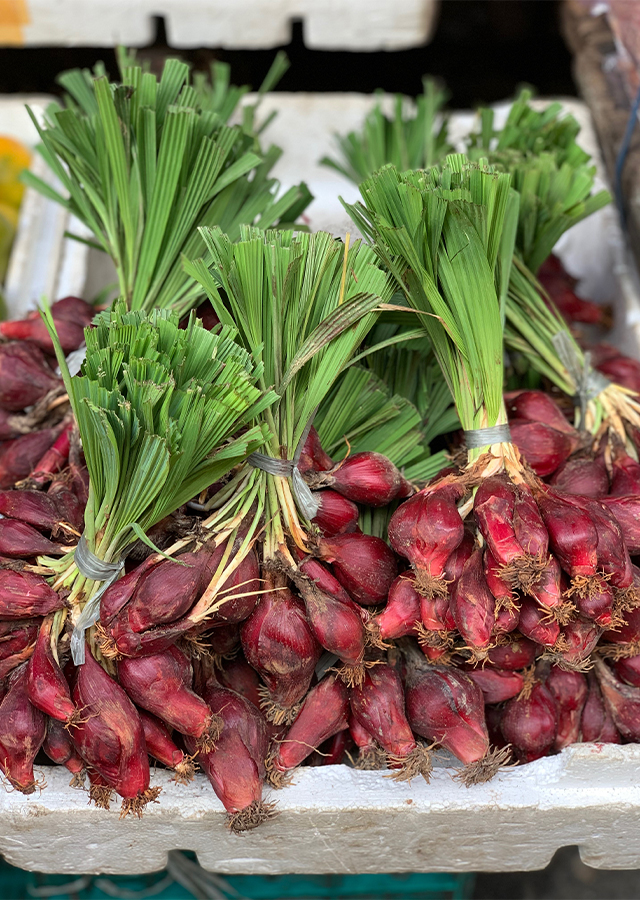Red Garlic
Eleutherine bulbosa (Mill.) Urb.
Iridaceae
Location in our garden
Principal



Synonym
Antholyza meriana Blanco
Bermudiana bulbosa (Mill.) Molina
Bermudiana congesta (Klatt) Kuntze
Eleutherine americana (Aubl.) Merr. Ex K.heyne
Habitus
Herbaceous. Annual bulbous herbaceous, grows up to 50–60 cm high. The plant parts that are often used are tubers and leaves
Part Used
Roots
Growing Requirements
Full Sunshine
Habitat
Mountains
Overview
Red Garlic, mainly from Kalimantan, Sarawak, and Sabah, is believed to be native to the island of Borneo. In the early 16th century, with the Portuguese from South America, the parent plant was possibly introduced to the island. Since then, the plants have been cultivated by local indigenous people, known collectively as Dayak, or Dyak, which is a general term for any Bornean native who is not Malay.
Native to: Argentina Northwest, Bolivia, Brazil Southeast, Brazil West-Central, Colombia, Cuba, Dominican Republic, Ecuador, French Guiana, Guyana, Haiti, Jamaica, Leeward Is., Paraguay, Peru, Puerto Rico, Suriname, Venezuela, Windward Is.
Introduced into: Angola, Cambodia, India, New Caledonia, Réunion, Trinidad-Tobago, Vietnam, Zaïre
Vernacular Names
Ajillo (Bolivia), Hua-Do (Ecuador), Kampanak (Peru)
Dayak onions/forest onions (Central Kalimantan/Indonesia), Sabrang onions (Sunda), onions
Kapal (Malay), and brambang sabrang (Central Java)
Agroecology
Compared to shady conditions, red garlic grows well in regions exposed to the sun. With a relatively short harvest season, this plant can grow and adapt to all climates and types of soil. At altitudes of 600-1,500 m, Dayak onion plants naturally grow.
Morphology
- Bulbs - 5–7 cm long and 3–4 cm width, ellipsoid, fleshy, red in colour and acrid. The bulbs on Sabrang onions do not smell at all. In onion bulbs, nests are composed of layers that are slightly thicker than other types of onion discs. The tuber height can reach 3-7 cm with a width of 1-3 cm
- Stems - terete, comprising one long internode, with a large cauline leaf at the apex, subtending the inflorescence.
- Leaves - narrowly lanceolate, plicate, entire along the margin, glabrous, many nerved. The location of the leaves in pairs with the composition of double-finned leaves. The type of leaf veins is parallel to the smooth leaf edge and the shape of the leaf is ribbon-shaped.
- Flowers - 2.0-5.5 cm long peduncles, borne on a secondary axis both in the axil of the cauline leaf and in umbellate form. 11-15 mm long spaths, green, glabrous, slightly frightening margins. Stamens 3, adnate to the outer tepal segments; 2-3 mm long, free, filiform filaments; 3-4 mm long, linear to oblong, orange-yellow anthers. 4 mm long ovary, obovoid, glabrous, tri-carpellary, tri-locular, tri-locular, filiform style, yellow, 2 mm long, 3-branched; branches as long as or slightly longer than the anthers, subulate; 2-4 ovules in each locule; ovules stalked, arranged in axile placentation. Flowers on sabrang onions have single flowers, with white color and some are yellow in the axils of the upper leaves, in flower clumps consisting of 4-10 flowers. Flowers will bloom from 5 pm to 7 pm. The flowers are cylindrical, the petals consist of 2 petals and the crown consists of 4 crowns. The pistil is yellow with a pistil 3-4 mm long, and in general there are four stamens.
Cultivation
Propagated by bulbs, can be planted directly
Chemical Constituents
Flavonoids, naphthoquinones, alkaloids, anthraquinones, saponins, tannins, triterpenoid, glycosides, and steroid.
Traditional Medicinal Uses
Medicinal Uses
- The bulb is widely known as a cure for bloody diarrhoea, haemorrhagia and open wounds, and also as a contraceptive in the literature and in herbaria.
- The root is used to treat infertility and haemorrhages in women.
Traditional Uses
- To kill intestinal parasites and worms, the red bulb is crushed and mixed with water and then drunk.
- Mixed with salt, the sap of the bulb is used as a treatment for epileptic fits. For the same reason, it is also often combined with rum and rubbed on the body.
- The bulb is used to treat sprains, to facilitate wound healing, and to cure tired blood in the form of plaster.
Breast cancer, diabetes mellitus, lower cholesterol, colon cancer, and prevent stroke.
Part Used
Reference Sources
- Fern, Ken. (2019). Useful Tropical Plants. Eleutherine bulbosa. http://tropical.theferns.info/viewtropical.php?id=Eleutherine+bulbosa. 06-12-2020
- Globinmed. (No date). Eleutherine bulbosa (Mill.) Urb. https://www.globinmed.com/index.php?option=com_content&view=article&id= 106238:eleutherine-bulbosa-mill-urb&catid=286&Itemid=357. 06-12-2020
- R. Prameela et all. (2018). Eleutherine bulbosa (Mill.) Urb. (Iridaceae): A new distributional record to the flora of Eastern Ghats, India. https://www.tropicalplantresearch.com/archives/2018/vol5issue3/38.pdf 06-12-2020.
- Dwinurmala L, Walahe D, & Arifin M. 2019. Pemberdayaan Masyarakat Desa Paris Mootilango Gorontalo Melalui Pendampingan Budidaya Bawang Dayak dan Pembuatan Teh Bawang Dayak. Jurnal Pengabdian Kepada Masyarakat Universitas Gorontalo 1(1): 22–27. Diakses tanggal 16 November 2021
- http://www.plantsoftheworldonline.org/taxon/urn:lsid:ipni.org:names:89940-2 di akses tanggal 16 November 2021
- Ekawati R. 2018. Pertumbuhan, Produksi Umbi dan Kandungan Flavonoid Bawang Dayak dengan Pemberian Pupuk Daun. J. Agrosintesa 1(1): 1–9. diakses tanggal 16 November 2021
- Kiswanto 2018. Respon pertumbuhan dan produksi bawang sabrang (Eleutherine bulbosa (L) Merr.) terhadap penyiangan dan pemberian biochar. Diakses tanggal 16 November 2021.



